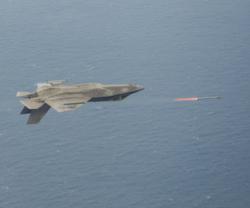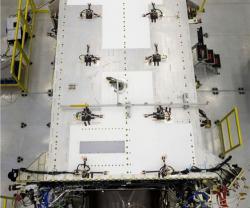Lockheed Martin to Enhance Space Systems Development
26.01.2011 North America
Lockheed Martin plans to increase the affordability and efficiency of space system development with the opening of a new advanced technology and virtual simulation facility, known as the Collaborative Human Immersive Laboratory (CHIL).
Located at Lockheed Martin Space Systems Company headquarters in Littleton, Colorado, CHIL integrates several virtual reality technologies enabling engineers and technicians to validate, test, and understand products and processes virtually before creating them physically. The result is a reduction in risk with savings in both time and cost.
The company will leverage the CHIL for a variety of programs, including the U.S. Air Force's next-generation Global Positioning System, known as GPS III and NASA's Orion Crew Exploration Vehicle. The laboratory can be applied to a range of space systems, including satellites, exploration spacecraft, launch vehicles and missile defense systems. Lockheed Martin Aeronautics has a similar facility, the Human Immersive Laboratory (HIL) that is already being used to reduce the life-cycle cost of aircraft.
Using motion tracking and virtual reality technology, the CHIL creates a unique collaborative virtual environment for exploring and solving problems quickly, and where hardware designs and manufacturing processes can be fine tuned before production or development begins. This allows engineers to identify risks and increase efficiencies early in program development, when the cost, risk and time associated with making modifications are low.
With a range of technology applications, the CHIL can improve every stage of a program, from the concept phase to the operations and sustainment phase. Using the CHIL, engineers can:
• Optimize and validate processes virtually before releasing them to manufacturing.
• Identify bottlenecks, collisions and workflow issues before they happen.
• Improve resource utilization, material flow and producibility.
• Reduce rework and mitigate program risk.
The CHIL integrates a variety of technologies including motion capture, immersive and portable systems to create its collaborative environment.
Located at Lockheed Martin Space Systems Company headquarters in Littleton, Colorado, CHIL integrates several virtual reality technologies enabling engineers and technicians to validate, test, and understand products and processes virtually before creating them physically. The result is a reduction in risk with savings in both time and cost.
The company will leverage the CHIL for a variety of programs, including the U.S. Air Force's next-generation Global Positioning System, known as GPS III and NASA's Orion Crew Exploration Vehicle. The laboratory can be applied to a range of space systems, including satellites, exploration spacecraft, launch vehicles and missile defense systems. Lockheed Martin Aeronautics has a similar facility, the Human Immersive Laboratory (HIL) that is already being used to reduce the life-cycle cost of aircraft.
Using motion tracking and virtual reality technology, the CHIL creates a unique collaborative virtual environment for exploring and solving problems quickly, and where hardware designs and manufacturing processes can be fine tuned before production or development begins. This allows engineers to identify risks and increase efficiencies early in program development, when the cost, risk and time associated with making modifications are low.
With a range of technology applications, the CHIL can improve every stage of a program, from the concept phase to the operations and sustainment phase. Using the CHIL, engineers can:
• Optimize and validate processes virtually before releasing them to manufacturing.
• Identify bottlenecks, collisions and workflow issues before they happen.
• Improve resource utilization, material flow and producibility.
• Reduce rework and mitigate program risk.
The CHIL integrates a variety of technologies including motion capture, immersive and portable systems to create its collaborative environment.
Previous PostBoeing: 6 P-8A Aircraft for US Navy
Latest news
Latest events
Doha International Maritime Defence Exhibition & Conference (DIMDEX 2026)
19 - 22 Jan 2026Doha - QatarUMEX – SimTEX
20 - 22 Jan 2026ADNEC Centre Abu Dhabi, - United Arab EmiratesWorld Defense Show (WDS) 2026
08 - 12 Feb 2026Riyadh - Saudi ArabiaSAHA EXPO International Defence & Aerospace Exhibition
05 - 09 May 2026İstanbul Expo Center - Turkey






















